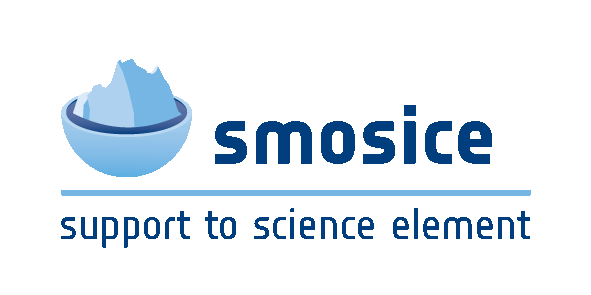
Project results
The aim of the SMOSIce study was to develop, improve and validate algorithms for sea ice thickness retrieval from the 1.4 GHz (L-band) data of the European Space Agency's (ESA) Soil Moisture and Ocean Salinity (SMOS) mission. SMOS payload is the Microwave Imaging Radiometer by Aperture Synthesis (MIRAS) measuring for the first time globally the L-band brightness temperature at a range of incidence angles and at different polarizations. Electromagnetic radiation at L-band wavelengths (about 21cm) emerge from deep inside the sea ice layer. The attenuation mainly depends on the relative brine volume which is a function of ice bulk salinity and temperature. The penetration depth is up to 1.5m for cold low-salinity sea ice and reduces to a few centimeters for saline sea ice at high temperatures. The potential to derive the ice thickness from L-band radiometry mainly depends on sea ice temperature and salinity.
Several different sea ice emissivity models and retrieval algorithms have been developed and assessed using independent ice thickness estimates. The independent ice thickness estimates include electromagnetic induction (EM) measurements, NASA's Operation IceBridge data, MODIS thermal infrared imagery, as well as model simulations. The models used are of different complexity and range from empirical freezing degree-day ice growth parameterisations over one- and two-dimensional thermodynamic sea ice models to advanced coupled dynamic-thermodynamic ocean-ice assimilation systems.
The assessment has shown a clear advantage of a retrieval method that accounts for variations in ice temperature and ice salinity. This retrieval method determines the maximum thickness that can be retrieved. Sensitivity studies as well as comparisons with MODIS ice thickness revealed significantly better performance of the retrieval based on the brightness temperature near nadir in comparison to the difference of vertically and horizonally polarised brightness temperatures in the higher incidence angle range.
For the production of a sea ice thickness data product we select an algorithm based on a forward model that includes a sea ice thermodynamic model and a three layer radiation model. During the iterative retrieval ice temperature and salinity are estimated from surface air temperature reanalysis and a weekly climatology of sea surface salinity. The retrieval model accounts for the thermodynamic effect of a snow layer parameterised as a function of ice thickness. The resulting sea ice thickness is corrected for the statistical influence of the thickness distribution function.
A sea ice thickness product including three winter (October 15 to April 15) seasons has been derived from SMOS Level 1C brigthness temperature and is distributed via the Integrated Climate Data Center at the University of Hamburg. The daily updated data products are available at https://icdc.zmaw.de/. The approximate uncertainties of the SMOS ice thickness retrieval are about 20% for ice thickness less than 30 cm and 100% for ice thickness more than half a meter with an ill-constrained upper limit. To determine changes of the total sea ice thickness and volume we recommend to use SMOS and CryoSat-2 data together because of their complementary error characteristics. We expect the greatest benefit of the SMOS data alone during the cold freeze-up periods when extensive areas of thin sea ice control the ocean-atmosphere heat exchange, which is important for weather and climate, as well as for operational marine applications. There is the need for more validation measurements in both hemispheres to further improve the retrieval algorithm.
Data
Links
SMOSIce User Workshop
A workshop to present the new SMOS ice thickness product, as well as the scientific and technical outcome of the ESA SMOSIce study took place at the University of Hamburg.
References
